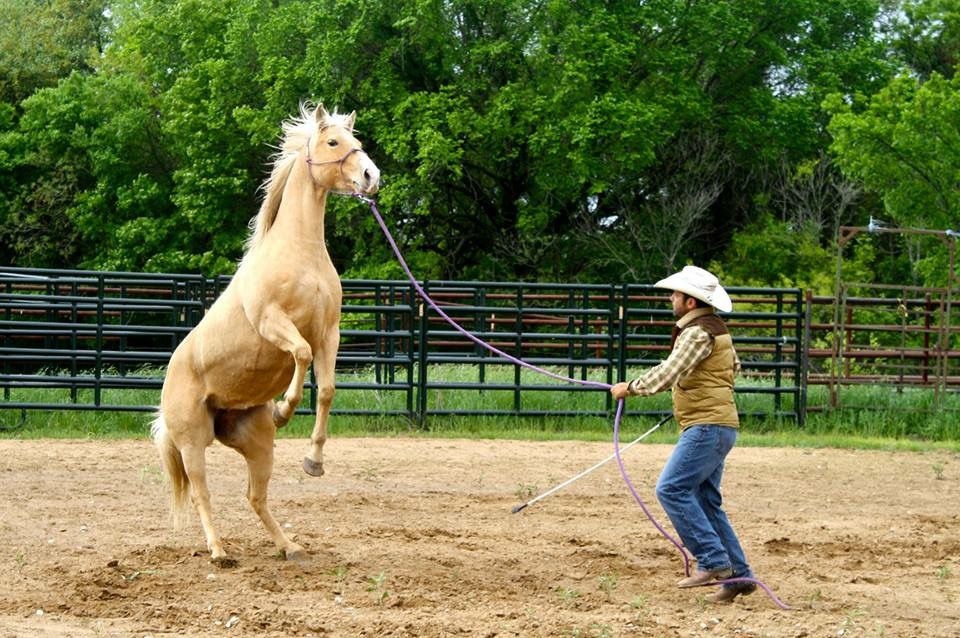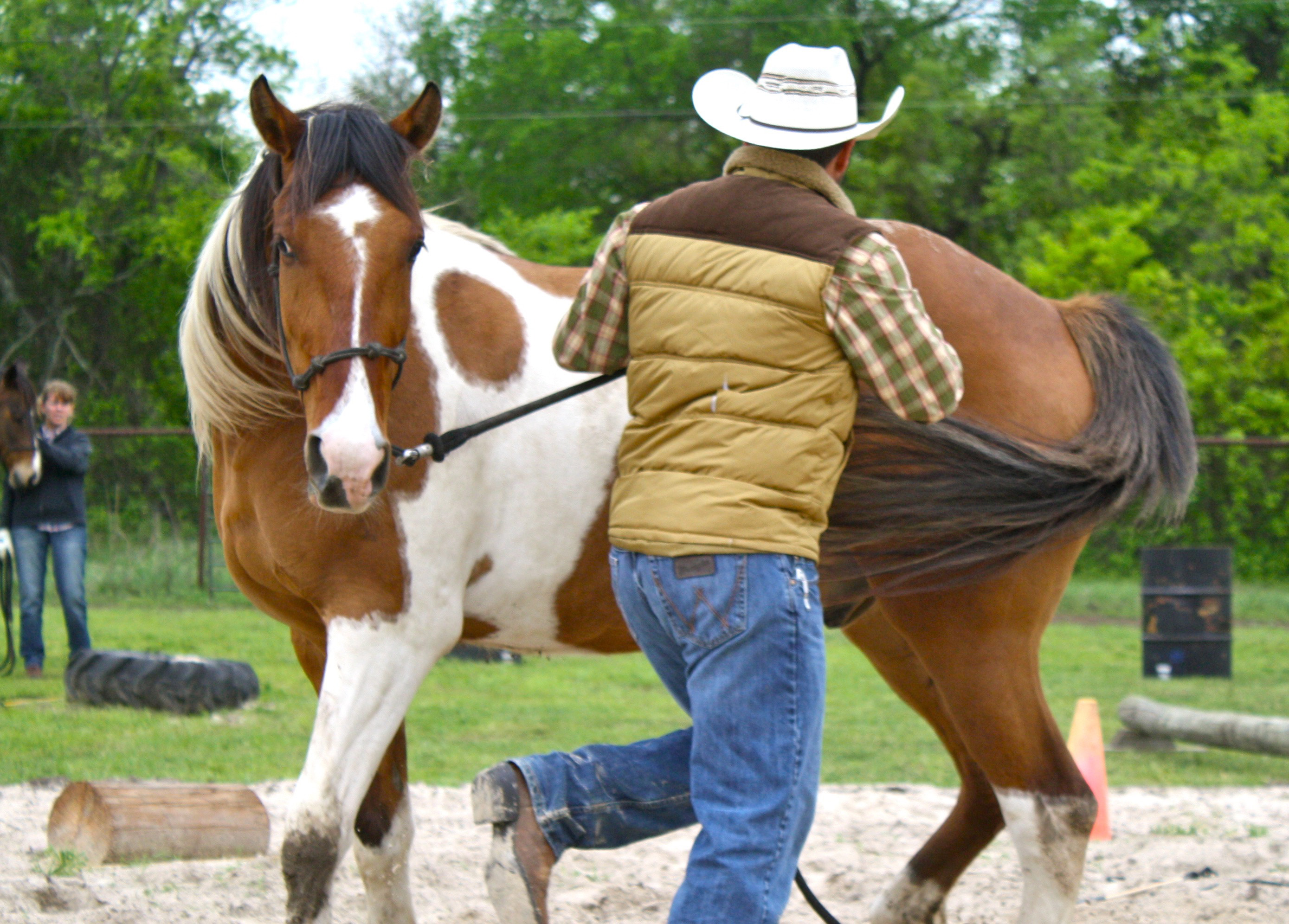HOME
Cold Backed Horses
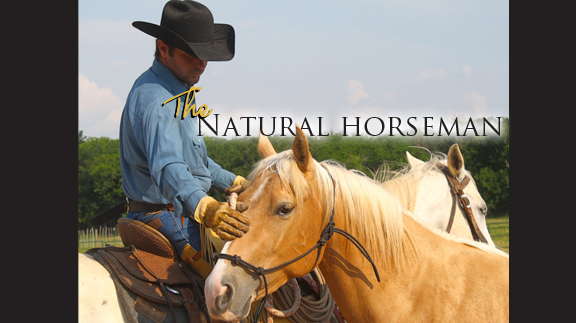
By Steve Stevens
This time of the year when the mornings are getting colder, horses are fresher and if they have a tendency for bucking, it will happen more often with the cooler weather.
We have a horse in training with us named Gus, a line-back dun gelding, who came to us originally for bucking off the owner about eight months ago.
Initially, just saddling him up and turning him loose in the round pen or lunging him on line, he would jump around a bit. I wouldn’t call him a bucker, just cold backed. After about five minutes of working him, he would quit. If you just got on him you could start bending him in circles or hustling his hindquarters around till he relaxed, which would take about five to ten minutes. He is the type of horse that with an inexperienced rider he could take advantage.
This type of horse needs consistent work, meaning going through a process of exercises for however many days it takes. With Gus, it only takes a few days for him to become a pretty nice horse that you can do about anything on. By the end of the 30 days of training you could throw a saddle on him with no warm up and just lope off and he was great.
Just last month Gus came back to us. He was back to his old routine. The owner had knee surgery which gave Gus some time off. Now with the owner just coming back from the surgery, Gus had been able to get away with his old bad habits. He had started bucking again and had been difficult for the owner. So, same as before, the first couple of days he had a little hump in his back and after that he went back to normal.
I think it is so important to have a process, to have exercises to get your horse’s mind off bucking before you get on: basic lunging, some desensitizing and most importantly, being able to see a horse move at all three gaits. Walk, trot, canter with the saddle on. You should be able to watch a horse move at all three gaits and say, “That looks like the kind of horse I would like to ride.” If a horse has a continuous bucking problem, it is important to have a vet look at him and make sure that he is not getting sore anywhere, and to make sure that you have correct saddle fit.
But sometimes, it is just the horse’s nature to be fresh and be a little cold backed. All the training in the world can’t fix that. But the preparation can make it so that it is not a big deal. It just takes a little more time and a little more consistency. That is always better than having hospital bills for you and your horse.
I believe the secret to this is not getting the horse tired, but GETTING HIS MIND. There is a big difference between the two.
Getting them tired, we just chase them around until they are out of breath. Maybe they get it out of their system, maybe they don’t. But after a while they get in better shape and you have to start chasing them longer and longer. You also then have to start riding and training on a tired horse which makes it harder for them to learn. Before long, it takes you an hour to get the fresh off of them and they have no interest in being with you at all.
The second option is getting their mind. We do that by changing directions and other exercises to give them something to focus on. Responding to them when they relax and releasing the pressure will teach them to look to you for leadership. Before long, it will take less and less time to get their mind.
With a horse like Gus, it is so important to build a foundation with basic building blocks: exercises so that we can direct his feet on the ground and when we are on his back.
We have to set our horses up for success. If we get on a fresh horse that hasn’t been worked for months and the horse starts bucking with us, we have set him and ourselves up for failure.
I will also say this—and I get this a lot after someone gets bucked off of their horse. They say they get back on because someone told them to or they heard that you can’t let the horse get away with that. That is fine with a professional horseman or horsewoman or a sure enough hand that can ride a horse through some bad stuff.
But, here is the reality. If a horse throws you off and you get right back on, there is probably a good chance they are going to do it again. I hear story after story where people do this and they get severely hurt. To me this is an ego thing. If someone else is telling you to get back on, ask that person if they want to show you and watch how quickly their expression changes. If you still get on and you get bucked off, it is your ego that will get you hurt, not your horse.
I sometimes want owners to look at it from the horse’s perspective. If horses buck us off and we get hurt, our husbands or wives could want us to get rid of the horse and then the horse goes to the sale and lives a life of continuous foster homes.
If we take our ego out of it and learn good horsemanship to get the horse’s mind, we probably could avoid a lot of wrecks.
Remember, horses don’t wear watches. So be sure to take all of the time that it takes to be safe so that you can help set up your horse for success.
Attractions
The Deadliest Prairie in Texas
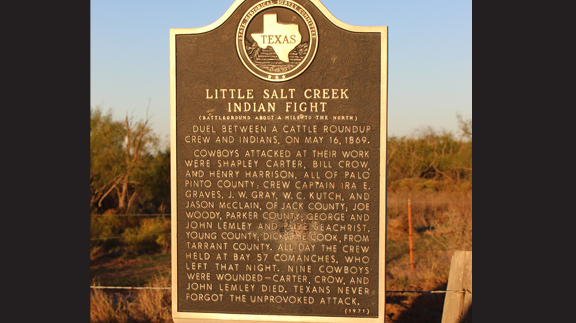
By Shannon Gillette
The Salt Creek Prairie with its rolling natural grasses and rampant wildflowers was a deceptive backdrop to the most dangerous prairie in Texas. Located in the northern section of Young County, the prairie absorbed an abundant amount of blood, shed from the battles between the encroaching white man and the Indians desperately trying to hold on to their home lands.
The Salt Creek Prairie was the location of several encounters between the Kiowa, Comanche and the area ranchers. The Indian Raid of Elm Creek on Oct. 13, 1867, resulted in the death of seven ranchers, five former Confederate Soldiers, the kidnapping of six women and children and the theft of 10,000 head of cattle. On May 18, 1871, the prairie witnessed another massacre when the Warren Wagon Train was hit by Kiowa under the command of Satanta, Satank and Big Tree. Seven members of the wagon train were murdered and forty-one mules stolen. But perhaps one of the bloodiest encounters was the Salt Creek fight on May 16, 1869.
Eleven cowboys under the watchful eye of their foreman, Captain Ira Graves were in the process of rounding up about five hundred head of their cattle about five miles southeast of present day Olney, Texas. The ranch hands were William Crow, John and George Lemley, C. L. Carter, Jason McClain, W. C. Kutch, J. W. Gray, Henry Harrison, Rube Secris, Joe Woody and a former slave known as Dick. They had noticed signs of recent Indian activity and were vigilant as they gathered the herd together. Each was armed with cap and ball six shooters. They had pointed the cattle towards the ranch and had made about four miles headway when they noticed a few more head grazing in the distance. Graves sent Carter and Kutch to gather them up. They had advanced about two miles when they spotted a large band of Indians approaching fast. Carter and Kutch could have taken cover in the sparse timber, but realized they would be leaving their companions in serious danger. The two groups met in the middle and tried to take cover in a small ravine that drained into the Salt Creek. The shallow-make shift fox hole offered very little protection.
The Indians attacked again and again. Arrows rained down on the cowboys in a continuous stream of painful blows. They attacked and retreated and attacked and retreated, but each time were met with volleys of gunfire from the small group of ranch hands. Each time the Indians retreated, they conferenced with their leader, who had stationed himself on a small hill away from the battle. After six hours of the constant onslaught, Graves developed a plan. When the Indians retreated, he ordered his men to stand and wave as wildly as they possibly could. The band of Indians, numbering over fifty strong, retreated for a final time, leaving the small band of cowboys alone.
As the dust settled the ranch hands evaluated their losses. In Kutch’s personal account given several years later, he described the aftermath: “Wm. Crow had been dead for several hours, and C. L. Carter had a severe arrow wound in his body, and had been also painfully injured with a rifle ball. John Lemley was mortally wounded in the abdomen with an arrow; J. W. Gray had been twice struck with rifle balls, once in the body and one in the leg; W. C. Kutch had two arrow heads in his knee and one in his shoulder; Jason McClain had been twice wounded with arrows; Rube Secris had his mouth badly torn, and his knee shattered; Geo Lemley had his face badly torn, and an arrow wound in his arm; and Ira Graves and Dick were also wounded.” Harrison was sent to Harmison Ranch for help.
The exhausted and wounded cowboys braved a very long and frightful night. With great relief, the morning hours brought the welcome sight of an incoming wagon. The rescuers patched the wounded as well as they could and sent word that doctors were needed desperately. The doctors did not arrive until a full twenty-four hours later. Carter passed away the next day from the injuries received during the battle. Two years later, McClain died while on another cattle drive. The cause of his death was blamed on the substantial injuries incurred on that fateful day in 1869.
While today the prairie grasses still wave and the wildflowers bloom in gorgeous arrays of colors nestled between cactus and mesquite, the blood shed is a distant memory. On crisp spring mornings it is easy to picture the deadly predicament that the cowboys faced.
This article originally appeared in the January 2016 issue of NTFR.
HOME
Preparing Spring Gardens

By Hannah Claxton | Editor
The North Texas area is located within USDA Hardiness zones seven and eight. The zones are categorized by predicted low temperatures for winter and timing of the first and last frosts.
Zone seven usually has winter low temps between 0 and 10 degrees F with the average date of the first frost falling between Oct. 29 and Nov. 15 and the average date of the last frost falling between March 22 and April 3.
Overall, these two zones have similar climates and growing conditions, making the options for timing and variety within a garden very similar.
In these zones, cool-season crops should go in the ground in March, meaning that soil preparation should start now.
To read more, pick up a copy of the January edition of North Texas Farm & Ranch magazine, available digitally and in print. To subscribe by mail, call 940-872-5922.
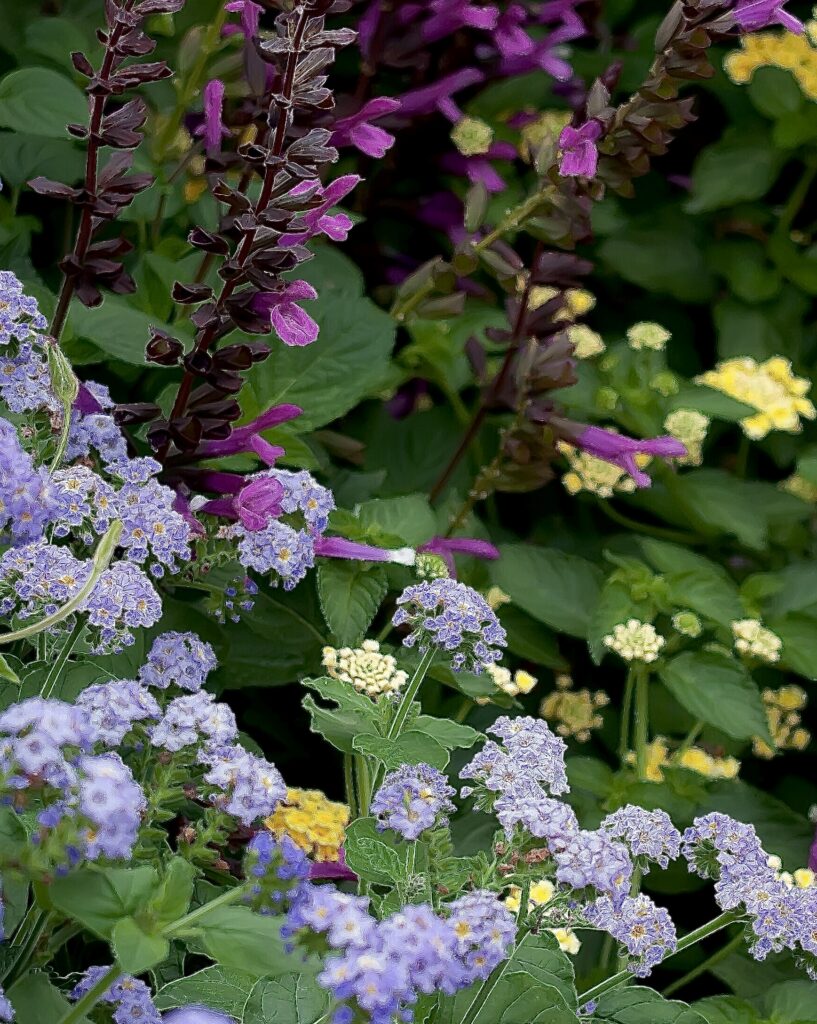
HOME
Equine Vaccinations
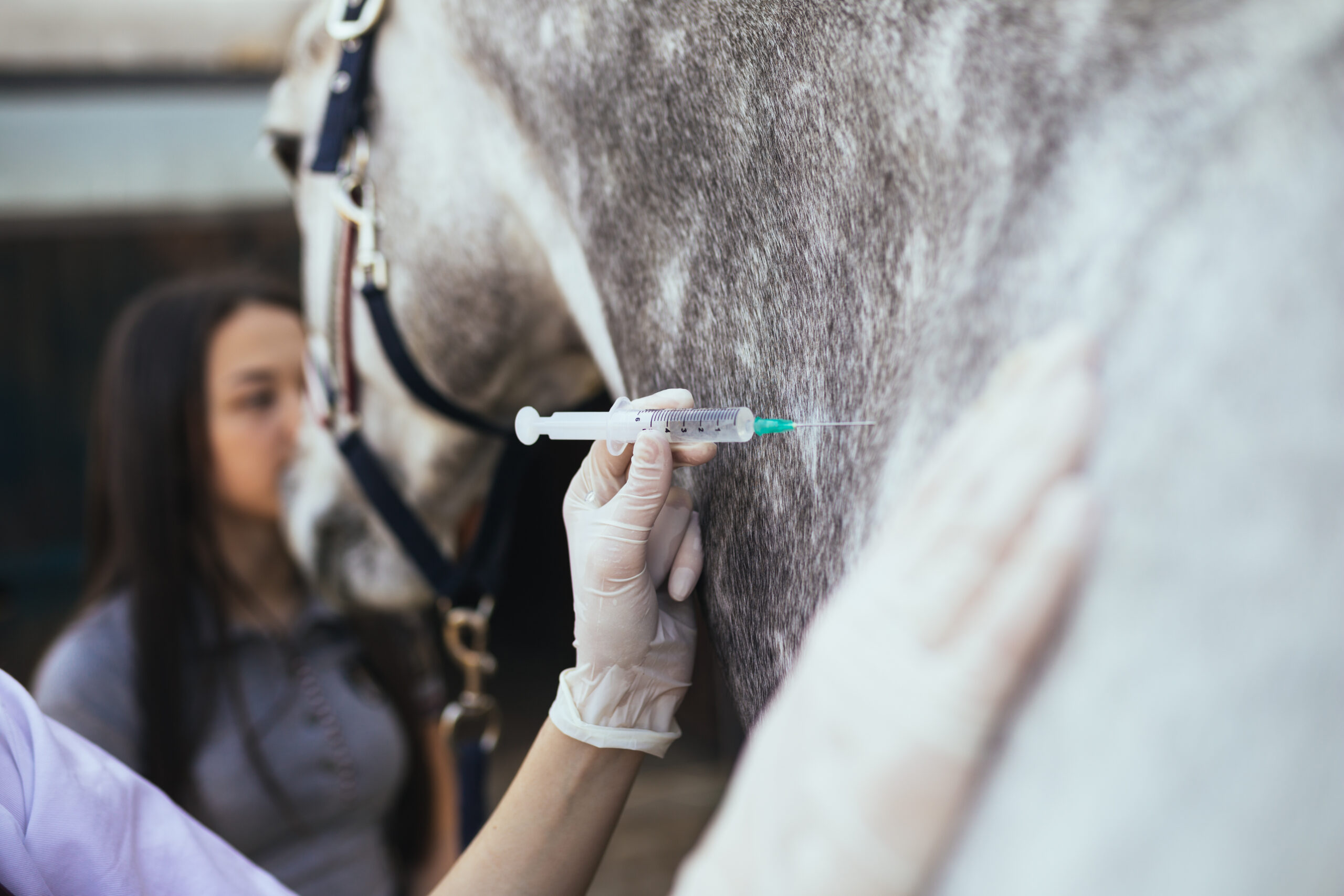
By Heather Lloyd
Vaccinations are a critical component of maintaining the health and well-being of horses, especially in environments where they are exposed to other animals, such as in the sport, show and performance arenas. Horses, like all animals, are susceptible to various infectious diseases that can spread quickly and cause serious harm.
A routine vaccination schedule helps prevent the spread of these diseases by preparing the horse’s immune system.
To read more, pick up a copy of the November edition of North Texas Farm & Ranch magazine, available digitally and in print. To subscribe by mail, call 940-872-5922.
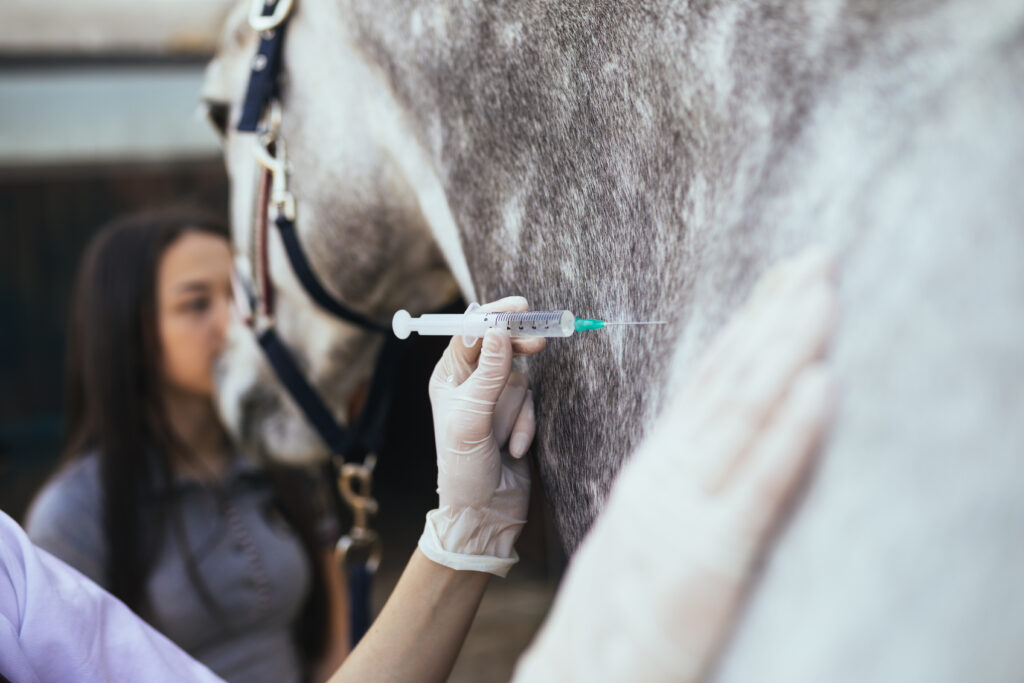
-

 Country Lifestyles2 years ago
Country Lifestyles2 years agoScott & Stacey Schumacher: A Growth Mindset
-

 Country Lifestyles8 years ago
Country Lifestyles8 years agoStyle Your Profile – What your style cowboy hat says about you and new trends in 2017
-

 HOME8 years ago
HOME8 years agoGrazing North Texas – Wilman Lovegrass
-

 Outdoor10 years ago
Outdoor10 years agoButtercup or Primrose?
-

 Country Lifestyles9 years ago
Country Lifestyles9 years agoJune 2016 Profile – The man behind the mic: Bob Tallman
-

 Country Lifestyles8 years ago
Country Lifestyles8 years agoDecember 2016 Profile, Rusty Riddle – The Riddle Way
-

 Country Lifestyles5 years ago
Country Lifestyles5 years agoAmber Crawford, Breakaway Roper
-
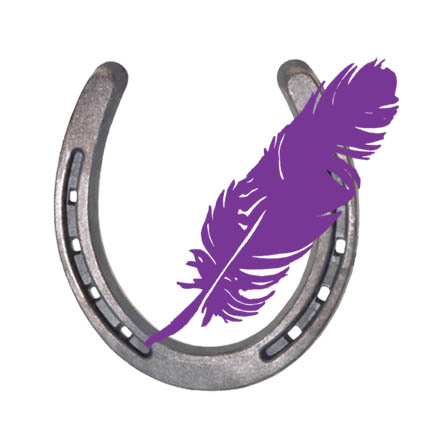
 Horsefeathers11 years ago
Horsefeathers11 years agoMount Scott: Country Humor with David Gregory

